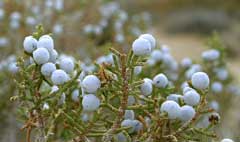
Californian Juniper, Chuperosa
Latin Name: Juniperus californica
USDA Hardiness: 8-10
Native Range: NORTHERN AMERICA: United States (Arizona (west), California, Nevada (south)), Mexico (Baja California (Norte))
Edibility Rating: 2 / 5
Medicinal Rating: 1 / 5
Region:
Family:
Plant Type:
Medicinal Uses
Edible Uses
Edible Parts: Fruit | Edible Uses: Fruit - raw or cooked. A thick, sweet, dry, fibrous and non-resinous flesh[82, 229]. It can also be dried and ground into a powder then used as a flavouring in various dishes or eaten as a mush[36, 61, 82, 105, 257]. The fruit is produced abundantly in the wild, though it is unlikely to be freely produced in Britain[K]. The cones are about 10 - 20mm in diameter[200].
Cultivation
Agroforestry uses: Junipers can be used as windbreaks or hedges and are often employed in erosion control due to their extensive root systems. They also provide habitat and shelter for wildlife. Landscape Uses:Erosion control, Rock garden, Screen, Specimen, Street tree. Succeeds in most soils if they are well drained, preferring a neutral or slightly alkaline soil[1, 11, 200]. Established plants are drought tolerant, succeeding in hot dry positions[200]. A slow-growing and generally long-lived tree[229], all introductions to Britain up to now (1990) have proved tender, this plant is only really suitable for hot dry climates[81]. Grows better in dry areas with hot summers, W. Britain is generally to cool and wet for this species to thrive[200]. The seed takes two summers to ripen[229]. Dioecious. Male and female plants must be grown if seed is required. Special Features:Attracts birds, North American native, Fragrant foliage, Inconspicuous flowers or blooms. Juniper berries (the fleshy cones) are typically harvested in late summer to early autumn depending on the species. Junipers produce male cones in spring, while the female cones develop into berries over the summer. Growth rates vary by species, but many Junipers are considered slow to moderate growers, typically reaching maturity in 5 to 15 years, depending on environmental conditions and species.
Known Hazards
None known
Habitats
Dry rocky, gravelly or sandy soils on dry mountain slopes and hills, 120 - 1200 metres[82, 229].
